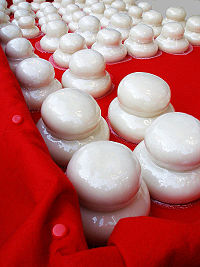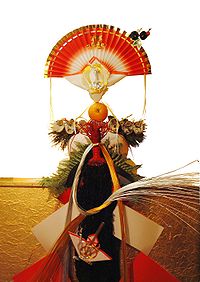
Kagami mochi
Encyclopedia


Japanese New Year
The is one of the most important annual festivals, with its own unique customs, and has been celebrated for centuries. Due to the importance of the holiday and the preparations required, the preceding days are quite busy, particularly the day before, known as Ōmisoka.The Japanese New Year has been...
decoration. It usually consists of two round mochi (rice cakes), the smaller placed atop the larger, and a daidai
Daidai
The daidai , is an Asian variety of bitter orange. The name daidai, originally meaning several generations, originates from the fruit staying on the tree for several years if not picked. The colour of the fruit returns to green in the spring.The daidai originated in the Himalayas...
(a Japanese bitter orange) with an attached leaf on top. In addition, it may have a sheet of konbu and a skewer of dried persimmon
Persimmon
A persimmon is the edible fruit of a number of species of trees in the genus Diospyros in the ebony wood family . The word Diospyros means "the fire of Zeus" in ancient Greek. As a tree, it is a perennial plant...
s under the mochi. It sits on a stand called a over a sheet called a , which is supposed to ward off fires from the house for the following years. Sheets of paper called folded into lightning shapes similar to those seen on sumo
Sumo
is a competitive full-contact sport where a wrestler attempts to force another wrestler out of a circular ring or to touch the ground with anything other than the soles of the feet. The sport originated in Japan, the only country where it is practiced professionally...
wrestler's belts are also attached.
The kagami mochi first appeared in the Muromachi period
Muromachi period
The is a division of Japanese history running from approximately 1336 to 1573. The period marks the governance of the Muromachi or Ashikaga shogunate, which was officially established in 1338 by the first Muromachi shogun, Ashikaga Takauji, two years after the brief Kemmu restoration of imperial...
(14th-16th century). The name kagami ("mirror") is said to have originated from its resemblance to an old-fashioned kind of round copper mirror, which also had a religious significance. The reason for it is not clear. Explanations include mochi being a food for sunny days, the 'spirit' of the rice plant being found in the mochi, and the mochi being a food which gives strength.
The two mochi discs are variously said to symbolize the going and coming years, the human heart, "yin" and "yang", or the moon and the sun. The "daidai", whose name means "generations", is said to symbolize the continuation of a family from generation to generation.
Traditionally the kagami mochi was placed in various locations throughout the house. Nowadays it is usually placed in a household Shinto altar, or kamidana
Kamidana
Kamidana , is a miniature Shinto shrine found in many Japanese homes. The kamidana is typically placed high on a wall and contains a wide variety of items related to Shinto-style ceremonies, the most prominent of which is the shintai, most commonly in the form of a small circular mirror, though it...
. It has also been placed in the tokonoma
Tokonoma
Tokonoma , also referred to simply as toko, is a Japanese term generally referring to a built-in recessed space in a Japanese style reception room, in which items for artistic appreciation are displayed. In English, tokonoma is usually called alcove. The items usually displayed in a tokonoma are...
, a small decorated alcove in the main room of the home.
Contemporary kagami mochi are often pre-moulded into the shape of stacked discs and sold in plastic packages in the supermarket. A mikan
Mikan
The satsuma is a seedless and easy-peeling citrus mutant of Japanese origin introduced to the West.In Japan, it is known as mikan or formally unshu mikan . In China, it is known as Wenzhou migan . The Japanese name is a result of the local reading of the same characters used in the Chinese...
or a plastic imitation daidai is often substituted for the original daidai.
Variations in the shape of kagami mochi are also seen. In some regions, three layered kagami mochi are also used. The three layered kagami mochi are placed on the butsudan
Butsudan
A butsudan is a shrine commonly found in temples and homes in Japanese Buddhist cultures. A butsudan is a wooden cabinet with doors that enclose and protect a gohonzon or religious icon, typically a statue or painting of a Buddha or Bodhisattva, or a "script" mandala scroll...
or on the kamidana. There is also a variant decoration called an okudokazari placed in the centre of the kitchen or by the window which has three layers of mochi.
It is traditionally broken and eaten in a Shinto
Shinto
or Shintoism, also kami-no-michi, is the indigenous spirituality of Japan and the Japanese people. It is a set of practices, to be carried out diligently, to establish a connection between present day Japan and its ancient past. Shinto practices were first recorded and codified in the written...
ritual called kagami biraki
Kagami biraki
Kagami Biraki is a Japanese traditional ceremony which literally translates to "Opening the Mirror" or, also, "Breaking of the Mochi." It traditionally falls on January 11 It refers to the opening of a Kagami mochi, or to the opening of a cask of Sake at a party or ceremony.-History:The fourth...
(mirror opening) on the second Saturday or Sunday of January. This is an important ritual in Japanese martial arts
Martial arts
Martial arts are extensive systems of codified practices and traditions of combat, practiced for a variety of reasons, including self-defense, competition, physical health and fitness, as well as mental and spiritual development....
dojo
Dojo
A is a Japanese term which literally means "place of the way". Initially, dōjōs were adjunct to temples. The term can refer to a formal training place for any of the Japanese do arts but typically it is considered the formal gathering place for students of any Japanese martial arts style to...
s. It was first adopted into Japanese martial arts when Jigoro Kano, the founder of judo
Judo
is a modern martial art and combat sport created in Japan in 1882 by Jigoro Kano. Its most prominent feature is its competitive element, where the object is to either throw or takedown one's opponent to the ground, immobilize or otherwise subdue one's opponent with a grappling maneuver, or force an...
, adopted it in 1884, and since then the practice has spread to aikido
Aikido
is a Japanese martial art developed by Morihei Ueshiba as a synthesis of his martial studies, philosophy, and religious beliefs. Aikido is often translated as "the Way of unifying life energy" or as "the Way of harmonious spirit." Ueshiba's goal was to create an art that practitioners could use to...
, karate
Karate
is a martial art developed in the Ryukyu Islands in what is now Okinawa, Japan. It was developed from indigenous fighting methods called and Chinese kenpō. Karate is a striking art using punching, kicking, knee and elbow strikes, and open-handed techniques such as knife-hands. Grappling, locks,...
and jujutsu
Jujutsu
Jujutsu , also known as jujitsu, ju-jitsu, or Japanese jiu-jitsu, is a Japanese martial art and a method of close combat for defeating an armed and armored opponent in which one uses no weapon, or only a short weapon....
studios.

